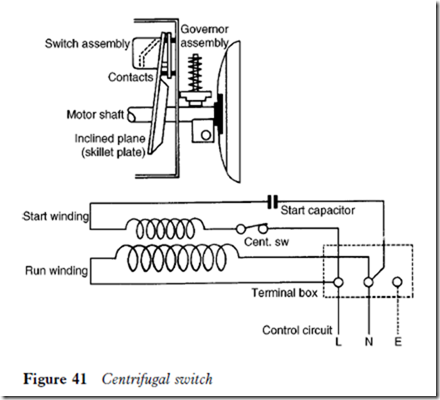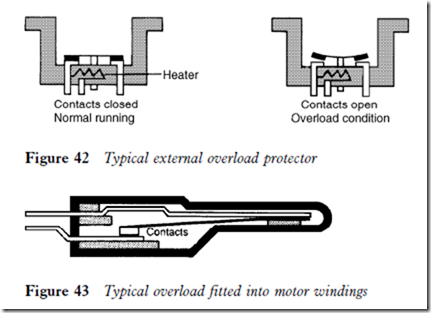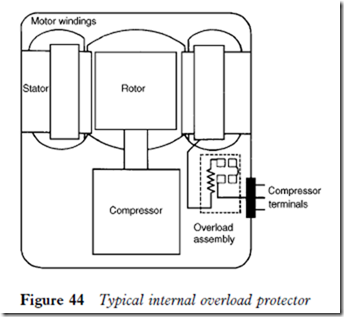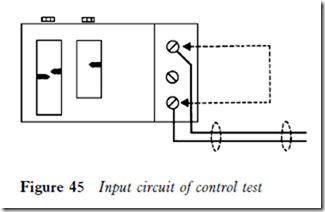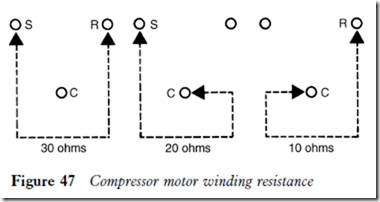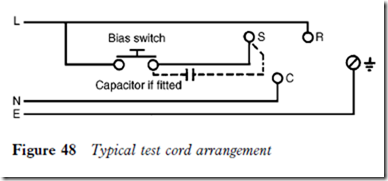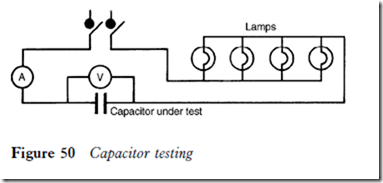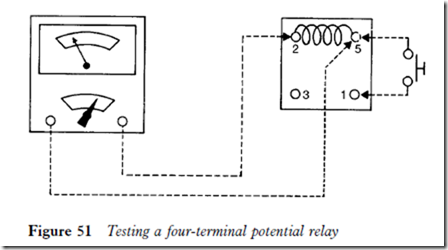Centrifugal switch (open-type motors)
This form of starting device is used on open drive motors. It comprises three major components: the switch contacts, the moving contact arm and the governor assembly (see Figure 41).
The switch contacts are wired in series with the supply and the start winding.
The governor assembly is mounted on the motor shaft. It consists of a spring loaded weight on a small rod. The spring loaded contact arm has a circular inclined plane extending around the shaft; this is commonly known as the skillet plate.
When the motor is idle, the switch contacts are closed. When the motor starts, the shaft rotates, gathers speed and sets up a strong centrifugal force which causes the weight to move outwards against the spring tension. This
permits the contact arm to move and open the switch contacts, thus disconnecting the start circuit.
As the supply is disconnected to the run winding by the action of the temperature control, the motor speed reduces and the centrifugal force weakens. This allows the governor to move in towards the shaft, contacting and depressing the skillet plate and closing the switch contacts ready for a restart.
Motor protection
The most common cause of motor failure is overheating. This condition is created when a motor exceeds its normal operating current flow. The result can be either a breakdown of the motor winding insulation and a short circuit, or a winding burn-out. For this reason, overload protection is provided in the form of a current and temperature sensitive control which will open the circuit before any damage to the motor can occur.
The following types of control are used: fuses, circuit breakers, bimetal switches and thermistors. Fuses and circuit breakers are located remotely and are normally required to protect the circuit conductors.
Bimetal switches are accepted as an overload protection for most hermetic and semi-hermetic motor compressors (Figures 42 and 43).
A thermistor is a solid state semiconductor which heats up as current is passed through it. As the temperature of the material of which it is made
increases, a greater resistance to current flow is created and under overload conditions the current flow very quickly almost ceases, thereby stopping the compressor. Most thermistors are made of lithium chloride or coated barium titanate. The resistance changes approximately 6 per cent of each degree C.
Thermistors that have a PTC are connected in series with the windings and prevent current flow when the temperature of the motor increases.
The negative temperature coefficient (NTC) device is a small module which is embedded in the motor windings. Internal overload protectors perform the same function as the external and thermistor types (Figure 44).
Motor overheating has various causes. Motor compressors used for refrigeration duty are designed to start when there is an equalizing of pressures within the compressor. An increased starting load such as a high head pressure can cause overheating and excess current to be drawn. A shortage of refrigerant can also result in overheating of the motor windings, since the motors rely on returning suction vapour to assist in the cooling of the windings.
Electrical test procedures
Supply and control switch
1 Check the electrical supply at the power point, the fuse and the fuse rating.
2 Ensure that the control switch is set to the on position, and check the electrical supply to the control. If there is supply to the input side of the
control, bridge out the control contacts with a jumper wire or join the two control wires together; this will effectively take the control out of circuit (Figure 45).
3 If the compressor fails to start, check the supply voltage at the compressor terminals or at the relay terminal board.
Overload protector
If the compressor is cold to the touch it is evident that it has been idle for some time. The overload protector should be checked for continuity or by bridging the two contacts as described for the control switch (Figure 46). Try to start the unit.
Windings
Isolate the unit electrically and remove the electrical leads from the compressor terminals, or the relay if it is a push-on type.
Check the compressor windings for continuity and resistance values (Figure 47). The highest resistance value between any two terminals is the
sum of two winding resistances (start and run terminals). The next highest resistance value between two terminals is the value of the start winding (start and common terminals). The lowest resistance value is that of the run winding (run and common terminals).
Test cord
If the check shows that the continuity and resistances are satisfactory, connect a test cord (see Figure 48). With the test cord connected, switch on the power supply. At this stage the compressor will be trying to start on the run winding only and a humming sound should be audible.
![]() Depress the test cord bias switch to bring the start winding in circuit, and hold for 2 3 seconds. The compressor should start. If the compressor starts when the start winding is in circuit but stops when the bias switch is released, the run winding is defective. Failure to start at all means that the start winding is defective. In either case a replacement compressor will be required.
Depress the test cord bias switch to bring the start winding in circuit, and hold for 2 3 seconds. The compressor should start. If the compressor starts when the start winding is in circuit but stops when the bias switch is released, the run winding is defective. Failure to start at all means that the start winding is defective. In either case a replacement compressor will be required.
A maximum deflection recorded on the ohmmeter indicates that the compressor motor is down to earth, and will probably blow fuses when the windings are energized.
When capacitors are included in the circuit they should be connected in series if a test cord is used; Figure 48 shows a start capacitor in series with the start winding.
The larger hermetic and semi-hermetic 220/240 volt a.c. 50 hertz capacitor- start/capacitor-run motor compressors draw considerable starting currents and it is advisable to use a heavy duty test cord similar to the type shown in Figure 49 when testing a compressor operation. The connection procedure is as follows:
1 With all switches in the ‘off’ position, attach the three motor leads of the test cord to the compressor terminals.
2 Attach a known good capacitor of the correct microfarad rating to the ‘start capacitor’ leads of the test cord. (If two start capacitors are fitted, connect them in parallel.)
3 Attach the appropriate capacitor to the ‘run capacitor’ leads of the test cord.
4 Move the ‘run capacitor’ switch to the ‘on’ position.
5 Ensure that the earth lead of the test cord locates to the compressor screw and makes good contact.
6 Connect the test cord to the mains supply.
7 Hold the start switch at the ‘on’ position and move the main switch to the ‘on’ position.
8 Release the start switch when the motor is up to speed.
If the compressor fails to operate it must be replaced. If the compressor runs on the test cord, then the fault may be in the overload protector or starting relay.
Capacitors
If the unit fails to start with the test cord it could also mean that the capacitor is unserviceable. It should be tested with a capacitor tester if available.
Another means of testing a capacitor is to connect it across a 50 Hz supply in series with an ammeter and several lamps to provide a resistive load. The voltmeter should be connected across the capacitor terminals as shown in Figure 50.
![]() Capacitance in microfarads (p,F) is given by (amperes/volts) ð 3200. For example, suppose a capacitor rating is 80 105. If the mains supply is 240 V 50 Hz and the current drawn is 7.5 A, then (7.5/240) ð 3200 D 100 p,F. This shows that the capacitor is functioning within the design rating. It must be emphasized that this method must not be used to select a capacitor.
Capacitance in microfarads (p,F) is given by (amperes/volts) ð 3200. For example, suppose a capacitor rating is 80 105. If the mains supply is 240 V 50 Hz and the current drawn is 7.5 A, then (7.5/240) ð 3200 D 100 p,F. This shows that the capacitor is functioning within the design rating. It must be emphasized that this method must not be used to select a capacitor.
Should a capacitor show any signs of leakage or damage to the outer casing, it should be changed.
Potential relay
First ensure that no capacitor in the circuit is defective or shows signs of leakage or damage.
1 Check for continuity by removing the relay and measuring the resistance across the relay coil (see Figure 51). In this case the reading is taken between terminals 2 and 5, but this may differ according to the relay type. A high resistance should be recorded. If a zero reading is recorded then the coil is open circuit.
2 Replace the relay and switch on the unit. If the contacts are stuck open, a humming sound should be heard; the compressor is trying to start on the run winding only. After 15 20 seconds the motor will trip out on the overload.
3 Isolate the unit and install a jumper wire across the switch terminals, in this case between terminals 1 and 2. Switch on the unit. The jumper wire should include a bias switch for safety.
4 Hold the bias switch in circuit for approximately 5 seconds to allow the compressor to reach its design speed. Then release the bias switch; the compressor should continue to run. This means that the relay contacts are stuck open.
This test will only be effective if the capacitors are serviceable, and is similar to using a test cord.
Related posts:
Incoming search terms:
- centrifugal switch
- what is the centrifugal switch hvac
- centrifugal switch image
- centrifugal switch conn
- motor centrifugal switch
- different kinds of centrifugal switch
- electrical circuit consisting of centrifugal switch capasitor running and starting winding
- how centrifugal switch connect with motor
- connection of centrifugal switch motor
- how ct drive triac in centrofugal switch circuit
- HOW TO IDENTIFY THE TERMINALS OF A CENTRIFUGAL SWITCH IN A 6 TERMINAL MOTOR
- motor centrifical switch and governor
- 44 Inclined plane Machine Suppliers @ionos com mail
- show what is centrifigo scwich in motor
- the connection of centrifugal switch?
- types of centrifugal switches
- what are the readings when you test a centrifugal switch
- what is centrifugal switch
- when the centrifugel starting switch false to open
- connection of a centrifugal switch
- connected centrifugal switch
- can a time delay be used on a compressor motor in place of a centrifugal switch
- cause of centrifugal switch damage in motor?
- centrefugal switch
- centrefugul switch
- centrifugal motor burnout or not
- centrifugal switch components
- centrifugal switch for compressor fridges f
- centrifugal switch m
- centrifugal switch made of motor which material
- centrifugal switch motor
- centrifugal switch motor connections
- centrifugal switch open
- centrifugal switch types
- centrifugal switch which conneceted in satarting winding
- cetrifugalswitch motor
- where is centrifugal switch lovated in electric maching
